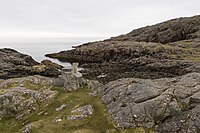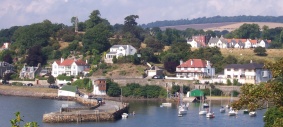
Aberdour is a scenic and historic village on the south coast of Fife, Scotland. It is on the north shore of the Firth of Forth, looking south to the island of Inchcolm and its Abbey, and to Leith and Edinburgh beyond. According to the 2011 census, the village has a population of 1,633.
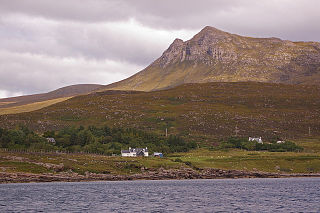
Achduart is a coastal hamlet in Coigach, Wester Ross in northwestern Scotland, now within the Highland council area. It is situated about 4 km southeast of the village of Achiltibuie, at the end of a minor road. A footpath continues on to the hamlet of Culnacraig, then along the coast past Ben More Coigach to Strathcanaird. Achduart has accommodation facilities for tourists, who come for its proximity to the sea and its seclusion and remoteness. There is a hostel in Acheninver, a short distance to the north, formerly run by the Scottish Youth Hostels Association. The name of Achduart comes from the Gaelic for "the field at the black headland". Achduart was part of the Estate of Coigach, Lochbroom, belonging to the Countess of Cromartie.

The Wilsons Promontory National Park, commonly known as Wilsons Prom or The Prom, is a national park in the Gippsland region of Victoria, Australia, located approximately 157 kilometres (98 mi) southeast of Melbourne.
Caister-on-Sea, also known colloquially as Caister, is a large village and seaside resort in Norfolk, England. It is close to the town of Great Yarmouth. At the 2001 census it had a population of 8,756 and 3,970 households, the population increasing to 8,901 at the 2011 Census.

Gairloch is a village, civil parish and community on the shores of Loch Gairloch in Wester Ross, in the North-West Highlands of Scotland. A tourist destination in the summer months, Gairloch has a golf course, a museum, several hotels, a variety of shops, takeaway restaurants, a community centre, a leisure centre with sports facilities, a local radio station, beaches and nearby mountains. Gairloch is one of the principal villages on the North Coast 500 route.
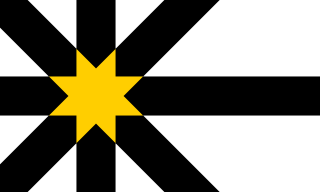
Sutherland is a historic county, registration county and lieutenancy area in the Highlands of Scotland. Its county town is Dornoch. Sutherland borders Caithness and Moray Firth to the east, Ross-shire and Cromartyshire to the south and the Atlantic to the north and west. Like its southern neighbour Ross-shire, Sutherland has some of the most dramatic scenery in Europe, especially on its western fringe where the mountains meet the sea. These include high sea cliffs, and very old mountains composed of Precambrian and Cambrian rocks.

The Mornington Peninsula is a peninsula located south of Melbourne, Victoria, Australia. It is surrounded by Port Phillip to the west, Western Port to the east and Bass Strait to the south, and is connected to the mainland in the north. Geographically, the peninsula begins its protrusion from the mainland in the area between Pearcedale and an area north of Frankston. The area was originally home to the Mayone-bulluk and Boonwurrung-Balluk clans and formed part of the Boonwurrung nation's territory prior to European settlement.
Berneray is an island and community in the Sound of Harris, Scotland. It is one of fifteen inhabited islands in the Outer Hebrides. It is famed for its rich and colourful history which has attracted much tourism. It lies within the South Lewis, Harris and North Uist National Scenic Area, one of 40 such areas in Scotland which are defined so as to identify areas of exceptional scenery and to ensure its protection from inappropriate development.
Glen Coe is a glen of volcanic origins, in the Highlands of Scotland. It lies in the north of the county of Argyll, close to the border with the historic province of Lochaber, within the modern council area of Highland. Glen Coe is regarded as the home of Scottish mountaineering and is popular with hillwalkers and climbers.
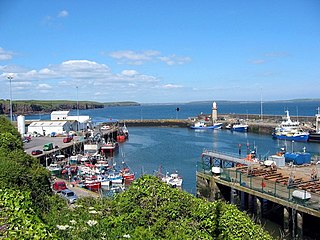
Dunmore East is a popular tourist and fishing village in County Waterford, Ireland. Situated on the west side of Waterford Harbour on Ireland's southeastern coast, it lies within the barony of Gaultier ; a reference to the influx of Viking and Norman settlers in the area.

Crianlarich is a village in Stirling council area and in the registration county of Perthshire, Scotland, around 6 miles (10 km) north-east of the head of Loch Lomond. The village bills itself as "the gateway to the Highlands".

Southend is the main settlement at the southern end of the Kintyre peninsula in Argyll and Bute, Scotland. It lies 8 miles (13 km) south of Campbeltown, the main town in the area. The civil parish of Southend comprises the village and the surrounding land, used mainly for farming and forestry. The population of the parish is 497.

Comrie is a village and parish in the southern Highlands of Scotland, towards the western end of the Strathearn district of Perth and Kinross, 7 mi (11 km) west of Crieff. Comrie is a historic conservation town in a national scenic area along the river Earn. Its position on the Highland Boundary Fault explains why it has more earth tremors than anywhere else in Britain. The parish is twinned with Carleton Place, Ontario, Canada.
Lochinver is a village that is located at the head of the sea loch Loch Inver, on the coast in the Assynt district of Sutherland, Highland, Scotland. A few miles north-east is Loch Assynt which is the source of the River Inver which flows into Loch Inver at the village. There are 200 or so lochans in the area which makes the place very popular with anglers. Lochinver is dominated by the "sugar loaf" shape of Caisteal Liath, the summit peak of nearby Suilven.

Assynt is a sparsely populated area in the south-west of Sutherland, lying north of Ullapool on the west coast of Scotland. Assynt is known for its landscape and its remarkable mountains, which have led to the area, along with neighbouring Coigach, being designated as the Assynt-Coigach National Scenic Area, one of 40 such areas in Scotland.

Coigach is a peninsula north of Ullapool, in Wester Ross in the Northwest Highlands of Scotland. The area consists of a traditional crofting and fishing community of a couple of hundred houses located between mountain and shore on a peninsula looking over the Summer Isles and the sea. The main settlement is Achiltibuie. Like its northerly neighbour, Assynt in Sutherland, Coigach has mountains which rise sharply from quiet, lochan-studded moorland, and a highly indented rocky coast with many islands, bays and headlands. The highest summit is Ben Mor Coigach at 743 metres; the distinctive profile of Stac Pollaidh is the other main peak within Coigach. The scenic qualities of Coigach, along with neighbouring Assynt, have led to the area being designated as the Assynt-Coigach National Scenic Area, one of 40 such areas in Scotland.

Achfrish is a hamlet situated towards the southeastern part of Loch Shin on the north side of the Loch in Highland, Scotland. It is also part of the wider community of Shinness which is made up of Achfrish, Tirryside, Achnairn, Colabul, Blairbuie and West Shinness. Achfrish is on the hill overlooking Loch Shin with views of Ben More Assynt to the West and Ben Klibreck to the North. Achfrish is approximately 4 miles from the larger village of Lairg which has a selection of shops, primary school and doctor's surgery. Secondary education is catered for in the coastal towns of Golspie and Dornoch.

Inchnadamph is a hamlet in Assynt, Sutherland, Scotland. The name is an anglicisation of the Gaelic name Innis nan Damh meaning 'meadow of the stags'. Assynt is a remote area with a low population density. Inchnadamph contains a few houses, a lodge, a hotel and a historic old church, graveyard and mausoleum.
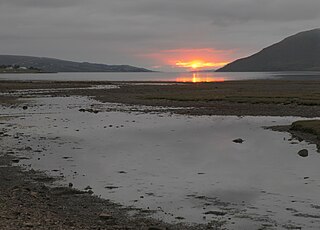
Dundonnell is a village in Ross and Cromarty, Scotland, on the south side of Little Loch Broom and at the foot of An Teallach, right at the north of the area commonly known as the "Great Wilderness". It is situated on the A832 road, 30 miles (48 km) east of Gairloch and 13.4 miles (21.6 km) west of Braemore Junction.

Cotton Tree Caravan Park is a heritage-listed caravan park at Cotton Tree Parade, Cotton Tree, Sunshine Coast Region, Queensland, Australia. It was added to the Queensland Heritage Register on 3 April 2009.


